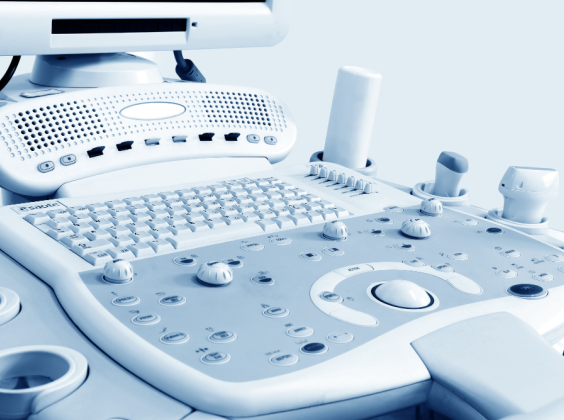
Written by

There were several ultrasound product launches from the major vendors at ECR 2018, with most prioritising workflow efficiency and image quality over advanced clinical features. Large displays, faster boot times, manoeverability and improved ergonomics were common across the product launches, with vendors striving to make ultrasound faster, more precise and more affordable. This insight summarises the products announced alongside our views on their likely impact on the market.
GE unveils Logiq E10
As the Logiq E9 approaches its 10th birthday, with global sales now topping 20,000 units, GE announced its latest premium ultrasound platform, the Logiq E10. GE claims that the NVIDIA GPU hardware architecture gives 48 times the data throughput and 10 times the processing power of previous systems. In addition to powering cSound, GE’s software beamformer image reconstruction platform, the additional processing power will be used for new, as yet unannounced, AI-based tools. In a first for GE, the E10 eliminates the need for focal zones as the entire image remains in focus throughout an exam. The E10 on display at ECR was kept at a distance with no clinical images on display, suggesting that it may not be fully ready for commercial launch.
GE and Canon are vying for top spot in the radiology ultrasound market and the E10 will face stiff competition from the Aplio i-series. GE is betting big on AI, not just for ultrasound but across its imaging modality portfolio and has invested heavily to establish an in-house AI capability. It has also fostered AI development partnerships with leading health providers (Massachusetts General Hospital, Brigham & Women’s Hospital, University of Pittsburgh Medical Center, etc.) and is establishing an ecosystem of third party algorithm developers on Health Cloud (currently includes Arterys, imbio and MedyMatch, but none of these are developing AI tools specifically for ultrasound). In this respect it may have a competitive edge over Canon; however, it remains to be seen how quickly GE can bring AI tools to market and how much value they will have to radiologists.
Siemens Launches Acuson Juniper
The Acuson Juniper is a mid-to-high end ultrasound system for shared services applications. Marketed under the tagline “Everything you need, nothing you don’t”, some of the features include a 21.5-inch LED display, 13.3-inch touch display, six transducer ports and 5 second boot time. Juniper has received CE Mark and FDA 510(k) clearance and will start shipping after ECR. It will likely replace the X600 and X700.
Juniper is targeted at one of the fastest growing segments of the ultrasound market (mid-range systems for shared services), albeit an increasingly competitive one. With other vendors adding advanced functionalities to their mid-to-high end systems, the stripped back Juniper may get lost in the crowd. Moreover, it will do little to strengthen Siemens’ position in the premium radiology market, where it has lost considerable ground in recent years. Siemens still needs a “best-in-class” premium platform to compete effectively, particularly with the imminent release of Logiq E10.
Canon Expands its Mid-Range Portfolio and Enters Tablet Ultrasound Market
Canon made three product announcements at ECR – two new series of mid-range ultrasound systems and a new tablet ultrasound system (5 new systems in total). The Xario g-series (Xario 200g and Xario 100g) of mid-range cart systems is designed to be maneuvered into tight spaces, such as the patient’s bedside, small examination rooms, operating theatres or emergency rooms. It offers up to 8 hours of battery life in full operational mode and has a 2 seconds boot-up time. The Aplio a-series builds upon the Aplio i-series architecture and features many of the same advanced clinical applications, but is defeatured to enable a lower price point. The a-series currently comprises the Aplio a450 and Aplio a550, the latter is the higher-end system, while Aplio a450 is a more compact unit. Viamo sv7 is a 12-inch tablet ultrasound system.
The slimline form factor of the g-series will enable Canon to more aggressively target point of care applications, where it currently has a relatively small market share in comparison to its strong positions in the radiology, and to a lesser extent OB/GYN, markets. The a-series is primarily targeted at shared service applications and is essentially an extension to the more feature reach i-series, but it will need to be carefully positioned to avoid cannibalising sales of the entry level i-series products, such as the i600.
The Viamo sv7 marks Canon’s entry into the tablet ultrasound market. The current version has a wired probe and Canon plans to add a wireless probe in the near future. The wireless version will give Canon an edge over the current batch of tablet ultrasound products which are all wired solutions (e.g. GE’s Venue 40 and 50, SonoSite’s iViz, Samsung’s UGEO PT60A, etc.). The Acuson Freestyle from Siemens is the only other large screen wireless systems from the major manufacturers, but it lacks a touchscreen interface. Although the Viamo sv7 looks well positioned for the tablet ultrasound market, this segment is likely to come under increasing pressure from lower cost, ultra-portable wireless handhelds, particularly as the image quality of handhelds continues to improve. Canon may have missed a trick by releasing a tablet rather than a handheld solution.
Mindray Accelerates its Evolution From Entry Level to Innovator
Mindray’s new X-Insight platform, which is currently available on the DC-80, DC-80A, DC-70 and DC-60, is based on three pillars:
- Immediate image clarity, achieved by a new GPU powered image processing engine (X-Engine), single crystal volume, convex and phased array transducers and ComboWave linear transducer technology, which uses a new type of composite piezoelectric material to optimise the acoustic spectrum and reduce acoustic impedance.
- All-Smart Exams – more intelligence to improve scanning efficiency and more precise.
- User comfort – large (21.5″/23.8″) full HD monitor, large (13.3″) touch screen and floating dual wing monitor arm.
The release of X-Insight strengthens Mindray’s growing reputation as a technically advanced global player, as it builds on its strong position in the value segment and further penetrates the mid-to-high end of the market. The Resona series is also set for a major upgrade this year. Whilst Mindray is yet to be considered a true innovator, the combination of advanced technology, competent image quality and aggressive pricing will continue to challenge the established market leaders.
Hitachi Releases a ‚’Smart’ Transducer
Hitachi Medical Systems announced “ScanSync”, which enables the operator to freeze, store and unfreeze images by auto detecting the transducer movement. For example, lifting the transducer away from the patient freezes the image. By reducing the need to use the control panel for these tasks, ScanSync could streamline workflow and it is well suited to applications where the operator cannot easily access the control panel, such as lower limb imaging. ScanSync is currently only available on ARIETTA Prologue.
Conclusion
Although none of the new ultrasound product annuncements at ECR can be considered revolutionary, the new platform releases by GE and Mindray point to the direction the ultrasound market is heading. More processing power from GPU architectures is enabling manufacturers to further improve their image processing technologies and at the same time create processing headroom to include advanced, AI-based tools, as they become available. AI will increasingly be applied to ultrasound devices, from automated system set-up and configuration, to workflow features (think Hitachi’s ScanSync), to image manipulation and interpretation. In addition to making ultrasound faster and more accurate, AI will help to expand the use of ultrasound by making it less operator dependent and by simplifying advanced clinical exams, such as multi-modality imaging. Manufacturers must invest and plan for AI now, or risk getting left behind.
Related Market Report
“Ultrasound Equipment – 2017 Edition” provides a data-centric analysis of the world ultrasound market. The report is based on 8 months extensive industry research and provides strategic insights and data on the current status of the market and our views on how the market will develop in the coming years.
About Signify Research
Signify Research is an independent supplier of market intelligence and consultancy to the global healthcare technology industry. Our major coverage areas are Healthcare IT, Medical Imaging and Digital Health. Our clients include technology vendors, healthcare providers and payers, management consultants and investors. Signify Research is headquartered in Cranfield, UK.
More Information
To find out more:
E: simon.harris@signifyresearch.net
T: +44 (0) 1234 436 150
www.signifyresearch.net
